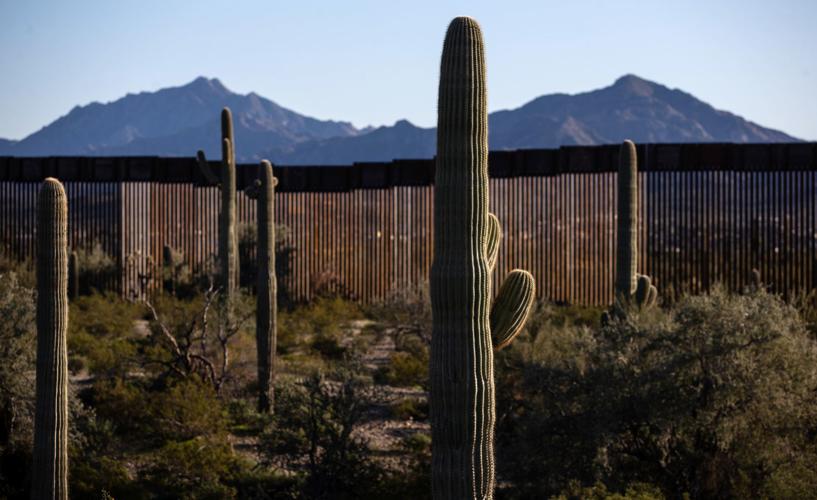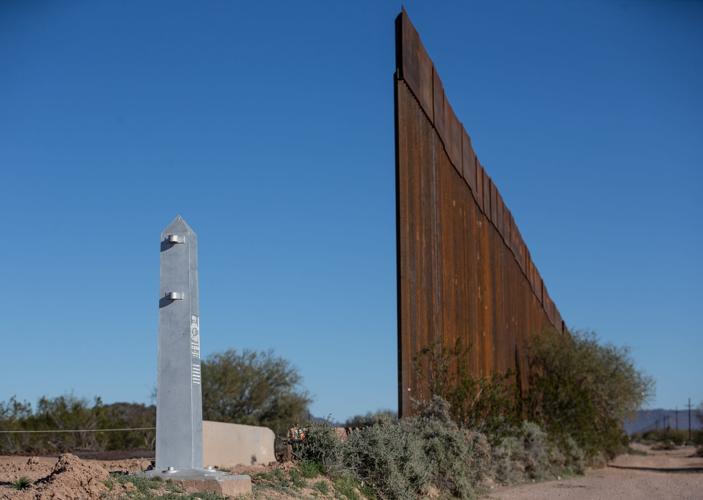The new 30-foot-tall steel sections of border wall some 150 miles southwest of Tucson now stretch from horizon to horizon in places on Organ Pipe Cactus National Monument.
On the dirt road that runs along the Mexican side of the border, the crest of each hill brings a glimpse of more rust-colored poles topped with metal plates erected in a flurry of construction that’s been going on since late August.
Until recently, the new border wall in the monument existed only on paper or in small sections a few miles from the port of entry at Lukeville, the main Arizona crossing to the beaches at Puerto Peñasco.
The long spans of new wall show the plan announced in May to build 43 miles of border wall here and in the adjacent Cabeza Prieta National Wildlife Refuge, at a cost of $891 million, is coming to fruition.
Steep-banked washes made the road impassable last week about 6 miles east of Sonoyta, the Mexican town across from Lukeville, but sections of the wall could be seen in the distance for at least another mile or two. The backdrop of the view was the Sierra de Santa Rosa Mountains that separate Organ Pipe and the Tohono O’odham Nation.
In the coming months, new wall will replace metal-mesh fencing near Lukeville and vehicle barriers — such as head-high bollards, post-and-rail fencing and Normandy-style barriers — along about 10 miles between Lukeville and the mountain range, but no farther.
Tohono O’odham officials did not allow Customs and Border Protection to replace vehicle barriers with the new wall. Instead, the Tohono O’odham said CBP could install more surveillance towers on tribal land near the border.
CBP did not provide the number of miles of new wall built so far in Southern Arizona, but the Arizona Daily Star saw five to 10 miles of new wall in Organ Pipe. While some sections of the wall spanned thousands of feet, other areas had gaps that ranged from a few dozen feet to hundreds of yards.
Tranquility and tractor-trailers
Last week, the serenity of the virtually untouched expanses of cacti and volcanic rock in Organ Pipe subtly changed to a bucolic scene east of Sonoyta, where farmland sloped downward from the border to the Rio Sonoyta.
Late afternoon sunlight glinted through water pouring out of a pump as farmers watered their fields. The only sounds outside of the wall construction areas were the tinny ring of a bell tied around a goat’s neck, part of a small herd, along with a few sheep, grazing near the new wall, and faint Norteño music coming from a nearby house.
Two coyotes scampered across the border through a gap in wall sections, hustling to get ahead of construction vehicles. They disappeared into the brush behind panels of 30-foot bollards, as the poles used in the new wall are known, stacked neatly on the dirt road on the U.S. side of the border.
Construction workers talked among themselves as they used cranes to maneuver bollard panels into the trenches dug for the wall. One unlucky worker down the road was stuck by himself holding a “Stop” sign. He counted out loud in English and Spanish in an apparent attempt to pass the monotonous hours.
The quiet on the east side of Sonoyta is a sharp contrast with the other side of town, where Mexico’s Highway 2 runs closer to the border and the roar of tractor-trailers is common.
That highway was used last year by thousands of families from Guatemala, Honduras and El Salvador who were dropped off on the side of the road, walked under the border’s vehicle barriers and claimed asylum. Central American families continue to flag down Border Patrol agents to claim asylum, but their crossing point is often many miles to the east near Sasabe.
border wall souvenir
While the new section of wall east of Lukeville will dead-end into the mountains, the new wall west of Lukeville will connect with other wall projects to cover most of the 120 miles between Lukeville and the Yuma area.
So far, construction crews have replaced vehicle barriers and metal-mesh fencing with the new wall along about two miles of the border west of Lukeville. For some 10 miles farther to the west, the dirt road that runs along the border is now twice as wide as it was last fall.
A man from New Jersey, one of numerous tourists taking advantage of the mild weather to visit Organ Pipe last week, pulled his car over near the new wall. Standing on the dirt road that runs next to the border, he had a “eureka” moment when he saw a small square of metal poking out of the dirt. He picked it up and dusted it off, excited about having a souvenir of the wall.
Nearby, a construction crew was installing bollard panels with large openings at the bottom in a wash that ran south into Mexico. As they worked, a woman who said she was a naturalized U.S. citizen splitting her time between Thailand and San Francisco drove a van up to the workers and offered to cook for them or help in any way she could.
Tourists drove along South Puerto Blanco Drive, a dirt-and-gravel road that meanders through the southern portion of Organ Pipe. The road was rutted last fall, but a steady stream of heavy construction vehicles appeared to have smoothed its surface.
About 10 miles west of the construction crew, several cars were parked near Quitobaquito Springs as drivers waited to tour the pond fed by the springs, which have slaked the thirst of countless travelers and animals for centuries.
The springs are a hundred or so feet north of the border. In response to concerns about the springs drying up during wall construction, CBP agreed not to use any wells within five miles of the springs for the hundreds of thousands of gallons of water needed every week to mix concrete for the wall and tamp down dust.
A yellow water tank, similar to one used for the wall project in Cochise County, was suspended above what appeared to be a well about eight miles east of the pond. CBP did not respond to an inquiry from the Star about the site.
As of last week, water still bubbled to the surface of a spring tucked into the granite north of the pond at Quitobaquito Springs. The water flowed down a channel into the reed-lined pond, which had clear water.
Blasting along the border
As construction has progressed in recent months, environmental advocates have raised concerns about the impact on Organ Pipe, which is part of the national park system and was designated as a biosphere reserve by the United Nations.
Hundreds of saguaros and other cacti were dug up and moved out of the construction zone. Others were destroyed outright. A National Park Service report last year cautioned that Tohono O’odham artifacts could be destroyed when the road along the border is cleared for construction.
Last week, construction crews started blasting along the border line that runs over Monument Hill near Lukeville. That news came just days after cottonwood trees were cut down at the San Pedro River in Cochise County to make way for a wall across the river.
In a statement Wednesday, Customs and Border Protection said the controlled blasting will occur through the month, and that an “environmental monitor” is on site “to ensure that if any previously unidentified culturally sensitive artifacts are observed within the project area, that construction is halted and the appropriate stakeholders are notified to include tribal nations.”
Environmental surveys and other input showed that “no biological, cultural, or historical sites were identified within the project area,” the agency said. The work area consists of a 60-foot-wide swath of land from along the borderline, CBP said in the statement.
Border Patrol agents say the area near Lukeville is controlled by drug cartels. The new wall will stop illegal traffic, they say, which will lessen the environmental impact caused by migrants walking through Organ Pipe and discarding water bottles, food wrappers, clothes and other items.
In one recent case, Border Patrol agents on Jan. 14 arrested six adults and a minor suspected of crossing the border illegally in Organ Pipe. Some in the group said they met at a house in Mexico and a guide brought them across the border on foot, according to a criminal complaint filed in Tucson’s federal court.
In late December, a Phoenix woman saw a Facebook post asking for drivers who would take someone from Lukeville to Phoenix for $3,400, according to another complaint. Agents saw her park at the gas station in Lukeville and wait for a woman who walked north from the border.
When the wall is completed, environmental advocates worry it will stop animals such as the Sonoran pronghorn antelope from migrating across the border.
As the wall goes up and the debate over it continues, dozens of children cheerfully walked through the Lukeville port of entry into Mexico last week after a day of school. Some of the children were so small it looked as if the weight of their backpacks might tip them over at any moment.






